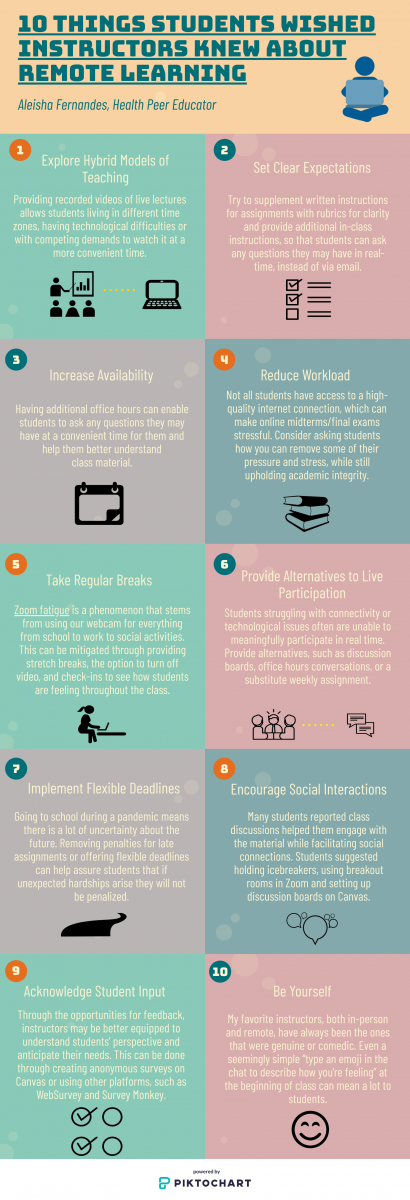
The switch to remote classes has been a trying experience for both students and instructors as they have had to adjust to an alternate mode of learning and teaching that some may never have experienced before. The Health Peer Educators, in conjunction with SFU Health and Counselling Services, did an informal Instagram poll a few weeks ago to learn more about students’ experiences with remote classes. Here are the resulting recommendations suggested by students from the poll as well as some recommendations outlined in the SFU Student Online Learning Experiences (SOLE) survey, delivered by the Centre of Educational Excellence earlier, for how instructors can improve the experience of students in remote classes.
1. Explore Hybrid Models of Teaching
In our poll, many students preferred synchronous learning, although there were a few that liked asynchronous learning more. The students who preferred asynchronous lectures reasoned that it allowed them to learn at their own pace, which can be especially beneficial for students living in different time zones. A good compromise could be a hybrid model that provides recorded videos of the live lectures, so that students living in different time zones or with competing demands, can watch it at a more convenient time while others can watch in real-time. This can also help students who experience internet connectivity or technological problems during the lecture.
2. Set Clear Expectations
In the SOLE survey, students advocated for more clarity with instruction and expectations. Some students reported feeling lost with assignments and feeling unsure about what is expected of them virtually. Try to supplement written instructions for assignments with rubrics for clarity and provide additional in-class instructions so that students can ask any questions they may have in real-time, instead of just via email.
3. Increase Availability
Additionally, in the SOLE survey, many students reported wanting more feedback, such as through timely emails, grades, or verbal assurance. In remote classes, more students reported feeling unsure about their instructor’s expectations. Having additional office hours can enable students to ask any questions they may have at a convenient time for them and help them better understand the class material. Students want to feel like they are supported and heard, as it can be difficult and lonely navigating Canvas and other online platforms for answers on their own while remote learning.
4. Reduce Workload
Not all students have access to a high-quality internet connection, which can make online midterms and final exams stressful. Although breaking down assignments into smaller quizzes may seem like an easy substitution, it may significantly increase the weekly workload of students. Instead, consider asking students how you can remove some of the pressure and stress, while still upholding academic integrity.
5. Take Regular Breaks
Zoom fatigue is a phenomenon that stems from using our webcam for many daily activities, including school, work, and social activities. By providing stretch breaks, the option to turn off the video, and check-ins to see how students are feeling throughout the class, instructors are better able to keep students engaged during lectures and reduce zoom fatigue.
6. Provide Alternatives to Participation
Participation marks online have created a disparity amongst students. Students struggling with connectivity or technological issues often are unable to meaningfully participate in real-time. Providing alternatives, such as discussion boards, office hours chats, or a substitute weekly assignment, allows all students to meaningfully contribute without their work environment affecting their grades.
7. Implement Flexible Deadlines
Going to a school during a pandemic means there is a lot of uncertainty about the future. Many students are struggling to make do with less than optimal equipment and some are trying to meet deadlines in different time zones. Removing penalties for late assignments or offering flexible deadlines can help assure students that if unexpected hardships arise, they will not be penalized.
8. Encourage Social Interactions
Although students will not be able to get the same interaction they would if the class were in-person, the interaction they can get in remote classes is still extremely valuable. One of the benefits of remote classes is that students are now able to e-meet students that they would probably never have met or have talked to in an in-person setting. Many students also reported class discussions helped them engage with the material while facilitating social connections. Students suggested holding quick icebreakers, using breakout rooms in Zoom, and setting up discussion boards on Canvas.
9. Acknowledge Student Input
Transitioning to remote learning is a new experience for both instructors and students. Many students want to share their feedback and insight but may be worried that their feedback will not be heard or acknowledged. Creating a safe space for students to provide feedback or suggestions enables everyone to benefit. This can be done by creating anonymous surveys on Canvas or using platforms such as WebSurvey and Survey Monkey. Through the opportunities for feedback, instructors may be better equipped to understand students’ perspectives and anticipate their needs.
10. Be Yourself
My favourite instructors, both in-person and remote, have always been the ones that were genuine or comedic. In one of my remote classes, my instructor’s dog started barking because she wanted to come into their office and my instructor brought her in to introduce her to us. My instructor also asked us if we had any pets and to send pictures in the chat. Not only did this moment make me want to keep coming to class, it really motivated me to do well in the course. Even a seemingly simple, “type an emoji in the chat to describe how you’re feeling” can mean a lot to students.

Beyond the Blog
-
Follow SFU Health and Counselling services on social media such as their Facebook, Instagram, and Twitter pages
-
Although campuses are closed for courses, SFU Health and Counselling is still open. Check out the events, workshops and supports they are offering students this semester














